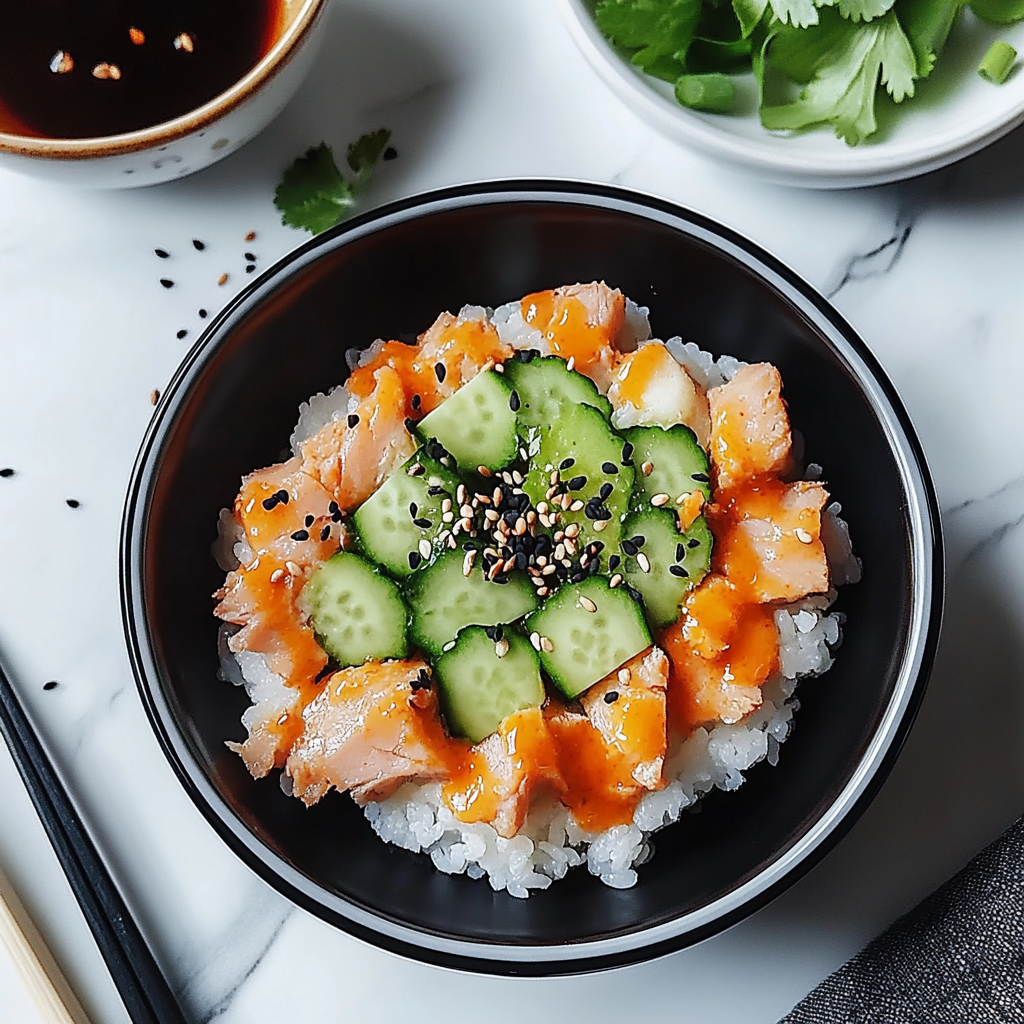Spicy Tuna Kimbap is a bold and flavorful twist on the classic Korean seaweed rice roll. It combines creamy, spicy tuna with fragrant rice, crunchy vegetables, and fresh greens, all wrapped in crisp seaweed. Perfect for lunches, picnics, or a quick, satisfying snack.
Why You’ll Love This Recipe
- Packed with spicy, savory flavor from tuna and gochujang or sriracha
- Easy and fast to prepare, especially with canned tuna
- Versatile and customizable to suit your taste
- Perfect for meal prep, lunchboxes, or on-the-go meals
- Naturally dairy-free and easy to make gluten-free
ingredients
(Tip: You’ll find the full list of ingredients and measurements in the recipe card below.)
- Cooked short-grain rice
- Sesame oil
- Sesame seeds
- Salt
- Roasted seaweed sheets (gim or nori)
- Canned tuna, drained
- Mayonnaise (Kewpie preferred)
- Sriracha or gochujang
- Scallions, finely chopped
- Perilla leaves or green leaf lettuce
directions

- Mix warm rice with sesame oil, sesame seeds, and salt to season.
- In a bowl, combine drained tuna, mayo, sriracha or gochujang, sesame oil, and scallions.
- Place a sheet of seaweed shiny side down on a bamboo mat.
- Spread a thin layer of rice over ¾ of the sheet, leaving the top ¼ bare.
- Lay perilla leaves or lettuce in the center, and add a line of the spicy tuna mixture.
- Roll the kimbap tightly using the mat. Press gently to seal.
- Brush with sesame oil and slice into bite-sized pieces using a sharp knife.
- Serve immediately or pack for later.
Servings and timing
- Servings: 2 rolls (~16 pieces)
- Prep time: 10 minutes
- Assembly time: 5 minutes
- Total time: 15 minutes
Variations
- Add cucumber, avocado, or pickled radish for extra crunch
- Use green leaf lettuce if perilla leaves aren’t available
- Swap in cooked salmon or tofu for tuna
- Adjust spice level by varying the amount of sriracha or gochujang
- Make triangle-shaped kimbap using a mold for portability
storage/reheating
- Store in an airtight container in the fridge for up to 24 hours
- Reheat gently by steaming or microwaving with a damp paper towel to soften rice
- Not freezer-friendly—rice will lose texture
FAQs
What’s the difference between sushi and kimbap?
Kimbap uses sesame oil-seasoned rice and cooked fillings, while sushi uses vinegar-seasoned rice and often includes raw fish.
Can I use leftover rice?
Yes, but warm it slightly and season it for best results.
How spicy is this recipe?
Mild to moderate—adjust the amount of sriracha or gochujang to your taste.
Can I make this gluten-free?
Yes—use gluten-free soy sauce or gochujang and check your canned tuna and mayo labels.
What’s a good substitute for perilla leaves?
Use green leaf lettuce, romaine, or shiso if available.
How do I stop my kimbap from falling apart?
Use sticky short-grain rice and roll tightly. A bamboo mat helps with even pressure.
Can I prep this ahead?
Yes—assemble in the morning and store tightly wrapped for the day.
How do I keep it from drying out?
Wrap in plastic wrap or store in an airtight container and eat within 24 hours.
What dipping sauce works well?
Soy sauce mixed with a little sesame oil, or spicy mayo, makes a great dip.
Can I make this vegan?
Yes—use mashed tofu or chickpeas mixed with vegan mayo and chili paste.
Conclusion
Spicy Tuna Kimbap is a quick, customizable, and flavorful meal that brings a touch of Korean comfort food to your table. Whether you’re packing lunch or craving a snack, this spicy roll delivers on taste and convenience.
PrintSpicy Tuna Kimbap
Seaweed rice rolls filled with spicy tuna, crisp vegetables, and savory seasonings—perfect handheld snacks or picnic bites.
- Prep Time: 15 minutes
- Cook Time: 0 minutes
- Total Time: 15 minutes
- Yield: 4 servings (32–40 pieces) 1x
- Category: Snack / Light Meal
- Method: No-cook assembly
- Cuisine: Korean
- Diet: Low Fat
Ingredients
- 2 cups cooked short-grain rice
- 1 Tbsp rice vinegar
- 1 tsp sugar
- ½ tsp salt
- 8 nori sheets
- 1 can (5 oz/140 g) tuna packed in water, drained
- 2 Tbsp mayonnaise
- 1 Tbsp gochujang (Korean chili paste)
- 1 tsp sesame oil
- 1 tsp soy sauce
- 1 small carrot, julienned
- 1 cucumber, julienned
- ½ avocado, sliced
- 4–6 pickle radish strips (danmuji)
- Optional: toasted sesame seeds for garnish
Instructions
- Mix rice vinegar, sugar, and salt into warm cooked rice; fluff and set aside.
- In a bowl, combine drained tuna, mayonnaise, gochujang, sesame oil, and soy sauce until well mixed.
- Place a nori sheet, shiny side down, on a bamboo mat or clean surface.
- Spread about ½ cup seasoned rice evenly over the nori, leaving a 1‑inch strip at the top edge.
- Lay a line of spicy tuna filling across the bottom third of the rice.
- Add julienned carrot, cucumber, avocado slices, and pickle radish alongside tuna.
- Roll tightly using the mat or fingers, applying gentle pressure to form a firm roll.
- Brush the exposed nori edge with a little water to seal the roll.
- Repeat for remaining ingredients to make 8 rolls total (cut each roll into 6–8 pieces).
- Sprinkle with toasted sesame seeds if desired and serve immediately or chilled.
Notes
- Use canned tuna in water for a lighter filling; tuna in oil adds richness.
- Adjust spiciness by varying gochujang amount, or swap for Sriracha.
- Add a strip of omelet or spinach for extra color and nutrition.
- Keep rolls covered with a damp cloth to prevent drying before slicing.
- Store in fridge for up to 1 day; wrap tightly to maintain shape.
Nutrition
- Serving Size: 2 rolls (approx. 6–8 pieces)
- Calories: 250 kcal
- Sugar: 3 g
- Sodium: 500 mg
- Fat: 8 g
- Saturated Fat: 1 g
- Unsaturated Fat: 5 g
- Trans Fat: 0 g
- Carbohydrates: 33 g
- Fiber: 2 g
- Protein: 12 g
- Cholesterol: 25 mg

